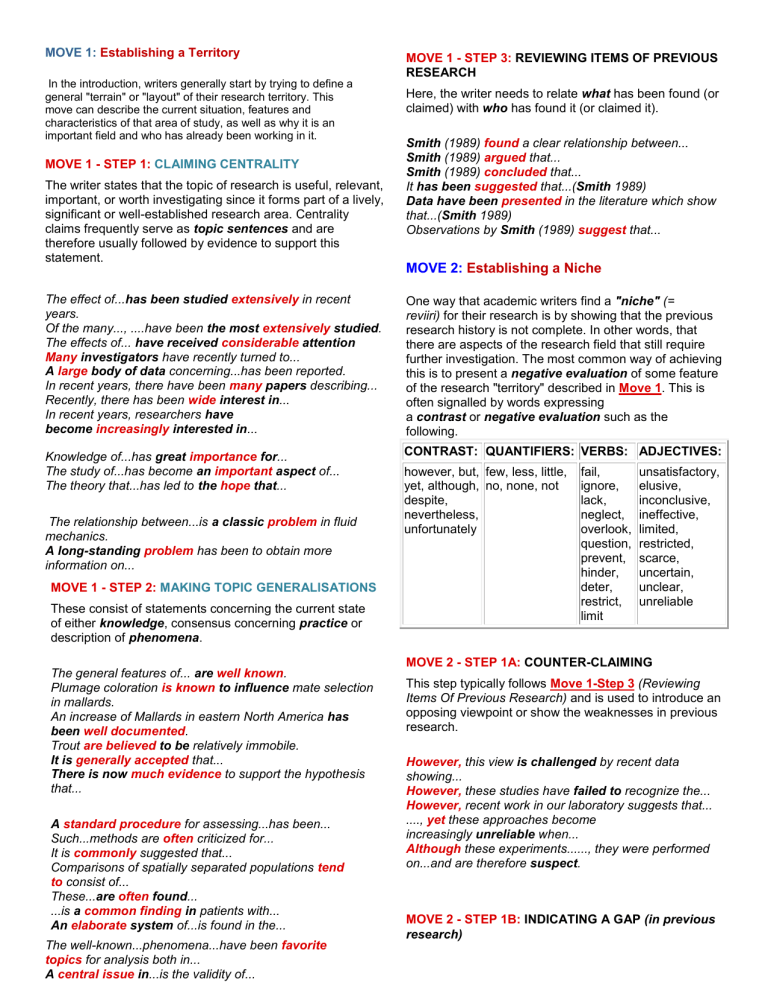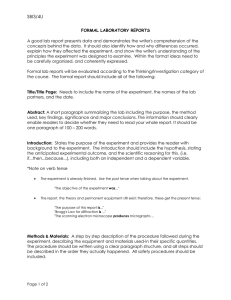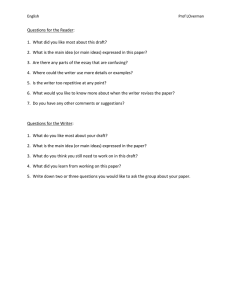
MOVE 1: Establishing a Territory
In the introduction, writers generally start by trying to define a
general "terrain" or "layout" of their research territory. This
move can describe the current situation, features and
characteristics of that area of study, as well as why it is an
important field and who has already been working in it.
MOVE 1 - STEP 1: CLAIMING CENTRALITY
The writer states that the topic of research is useful, relevant,
important, or worth investigating since it forms part of a lively,
significant or well-established research area. Centrality
claims frequently serve as topic sentences and are
therefore usually followed by evidence to support this
statement.
MOVE 1 - STEP 3: REVIEWING ITEMS OF PREVIOUS
RESEARCH
Here, the writer needs to relate what has been found (or
claimed) with who has found it (or claimed it).
Smith (1989) found a clear relationship between...
Smith (1989) argued that...
Smith (1989) concluded that...
It has been suggested that...(Smith 1989)
Data have been presented in the literature which show
that...(Smith 1989)
Observations by Smith (1989) suggest that...
MOVE 2: Establishing a Niche
The effect of...has been studied extensively in recent
years.
Of the many..., ....have been the most extensively studied.
The effects of... have received considerable attention
Many investigators have recently turned to...
A large body of data concerning...has been reported.
In recent years, there have been many papers describing...
Recently, there has been wide interest in...
In recent years, researchers have
become increasingly interested in...
One way that academic writers find a "niche" (=
reviiri) for their research is by showing that the previous
research history is not complete. In other words, that
there are aspects of the research field that still require
further investigation. The most common way of achieving
this is to present a negative evaluation of some feature
of the research "territory" described in Move 1. This is
often signalled by words expressing
a contrast or negative evaluation such as the
following.
Knowledge of...has great importance for...
The study of...has become an important aspect of...
The theory that...has led to the hope that...
CONTRAST: QUANTIFIERS: VERBS: ADJECTIVES:
The relationship between...is a classic problem in fluid
mechanics.
A long-standing problem has been to obtain more
information on...
MOVE 1 - STEP 2: MAKING TOPIC GENERALISATIONS
These consist of statements concerning the current state
of either knowledge, consensus concerning practice or
description of phenomena.
The general features of... are well known.
Plumage coloration is known to influence mate selection
in mallards.
An increase of Mallards in eastern North America has
been well documented.
Trout are believed to be relatively immobile.
It is generally accepted that...
There is now much evidence to support the hypothesis
that...
A standard procedure for assessing...has been...
Such...methods are often criticized for...
It is commonly suggested that...
Comparisons of spatially separated populations tend
to consist of...
These...are often found...
...is a common finding in patients with...
An elaborate system of...is found in the...
The well-known...phenomena...have been favorite
topics for analysis both in...
A central issue in...is the validity of...
however, but, few, less, little,
yet, although, no, none, not
despite,
nevertheless,
unfortunately
fail,
ignore,
lack,
neglect,
overlook,
question,
prevent,
hinder,
deter,
restrict,
limit
unsatisfactory,
elusive,
inconclusive,
ineffective,
limited,
restricted,
scarce,
uncertain,
unclear,
unreliable
MOVE 2 - STEP 1A: COUNTER-CLAIMING
This step typically follows Move 1-Step 3 (Reviewing
Items Of Previous Research) and is used to introduce an
opposing viewpoint or show the weaknesses in previous
research.
However, this view is challenged by recent data
showing...
However, these studies have failed to recognize the...
However, recent work in our laboratory suggests that...
...., yet these approaches become
increasingly unreliable when...
Although these experiments......, they were performed
on...and are therefore suspect.
MOVE 2 - STEP 1B: INDICATING A GAP (in previous
research)
This step typically follows Move 1-Step 2 (Making Topic
Generalisations) and indicates an unfilled
research "niche" (= reviiri) or a new way to approach
the research problem that the writer intends to pursue.
The present tense tends to be used when the aims are
described in terms of the written product, now held
physically in the reader's hands.
(paper, article, thesis → PRESENT tense)
A considerable amount of research has
been... but little research...
...has been extensively
studied. However, less attention has been paid to...
As a result, no comprehensive theory appears to exist.
Despite the importance of..., few researchers have
studied...
Research has tended to focus on...rather than...
The only reported study to date
of...covered a limited range of...
...studies have appeared previously in the
literature, but measurements were restricted to...
The properties of...are still not completely
understood.
Evidence on this question is presently inconclusive.
MOVE 2 - STEP 1C: RAISING A QUESTION (about
previous research)
However, it is not clear whether the use of...can be
modified to...
In spite of these early observations, the
mechanism...has remained unclear.
The question remains...?
How much has the seal population actually decreased?
MOVE 2 - STEP 1D: CONTINUING A TRADITION
This step is frequently signalled by causative connectors,
such as therefore, hence, consequently or thus, as well
as other expressions indicating a need for further
research.
These differences need to be analyzed...
Hence, additional studies of...are needed.
It is desirable to carry out surveys of...
It is of interest to compare....
MOVE 3 - STEP 1A: OUTLINING PURPOSES (Why?)
In this step, the writer introduces his/her solution to the
problem described in Move 2 by stating the
main purpose or aim of the study. Note in the examples
below how the verb tense used depends on whether the
writer is referring to a physical or abstract concept.
PRESENT TENSE:
The purpose of this paper is to...
The purpose here is to evaluate...
PAST TENSE:
The past tense tends to be used when the aims are
described in terms of abstract concepts such as mental
enquiry.
(study, investigation, experiment → PAST tense)
The aim of the present study was to elucidate...
The objective of this research was to quantify...
Our purpose was to describe...
Unlike Finnish, Japanese and Korean, English can (and
actually prefers to) take an inanimate agent as
the grammatical subject of the sentence.
HUMAN AGENT:
In this study, we suggest a 3-step process...
In this letter, we propose a ...algorithm.
In this paper, we attempt to develop a...
In this letter, we provide a novel approach to...
In this paper, we describe novel algorithms for...
In this paper, we present a system for...
In this letter, we analyze the performance of...
In this letter, we present an efficient routing protocol
that...
INANIMATE AGENT:
This paper evaluates the effect on...
This paper presents data on...
This study focuses on a strategy for...
The present study tested...
This thesis proposes a formal procedure for...
This paper introduces a novel architecture for...
This research aims to develop a methodology for...
MOVE 3 - STEP 1B: ANNOUNCING PRESENT
RESEARCH (How? Where? When?)
This step represents an alternative strategy to that used
in Move 3 - Step 1A. Here, the writer describes the aims
in terms of the steps taken in the study to reach its
objectives (i.e., how the research sets out
to“accomplish” the aims).
In this paper, we introduce a novel method to...
We use the method of… , in which…. An approximation
using a … algorithm similar to that of [6] is used
to evaluate …
In this paper, we provide a novel approach to model the
dynamic behavior of …. We first propose the …
functions of … regions based on the geometric
relationship between… and …. We model the … for a
wide variety of situations. The …
criterion is then applied to detect the … based on a test
statistic, which is a function of the … relationship
between … and …. We also demonstrate how to use
this technique in … systems to maximize ...
In this paper, we identify the security problems that …
face by developing an application in which… would be
used in the near future… We identify the threats and
vulnerabilities to this application …. This
paper details why security mechanisms that are
presently used in … environments are inadequate or not
appropriate for … designed for this application. We
then describe a new security model that serves as a
countermeasure to the identified threats.
MOVE 3 - STEP 2: ANNOUNCING MAIN FINDINGS
In this step, the writer considers the results to be the
most important aspect of the research and therefore
reports these as part of the introduction. Beware, not all
disciplines allow this in the Introduction Section!
In this paper, we argue that...
Here, we report a new method for...
This paper hopes to show that...
MOVE 3 - STEP 3: INDICATING ARTICLE
STRUCTURE
this step is more commonly found in dissertations and
theses than in research articles. However, many
disciplines that do not use the IMRD structure, such as
engineering, the humanities, and economics, typically
require writers to preview how the rest of the article will
be organized.
First, the writer intoduces the structure with a topic
sentence:
We have organized the rest of this paper in the
following way...
This paper is structured as follows...
The remainder of this paper is divided into five
sections...
Next, the writer has three alternative structures that can
be used to describe each section (in research
articles, reports, and essays) or chapter (
in theses or dissertations):
Author as actor:
In Section II, we describe the framework used to...
In Section IV, I present the model used to...
Text as actor:
Section II describes the framework used to...
Section IV presents the model used to...
Content as subject:
In Section II, the framework is described that was used
to...
In Section IV, the model is presented...
MOVE 3 - STEP 4: EVALUATION OF FINDINGS
This step is most often found in research that aims to
develop new methods, such as chemistry and
engineering. However, in most fields evaluation of the
results is left until the Discussion Section. Typically, this
step is the opposite of Move 2 in that it requires positive
evaluation of some aspect of the solution.
We have developed a procedure for detection of the
sickle cell mutation that is very rapid and is at least two
orders of magnitude more sensitive than standard
Southern blotting.
Numerical results show that the proposed
algorithm not only enjoys advantages of low
complexityand ease of implementation but is also able
to achieve performance very close to the optimum
achievable bound




